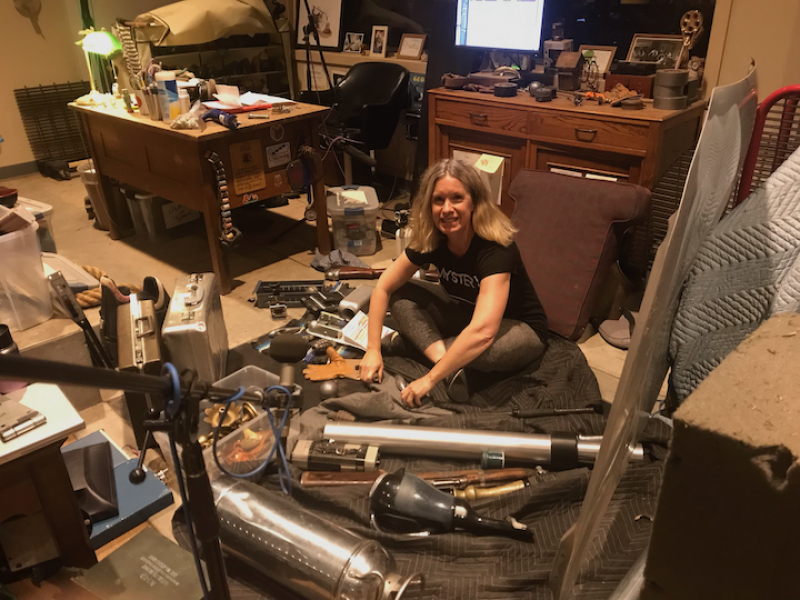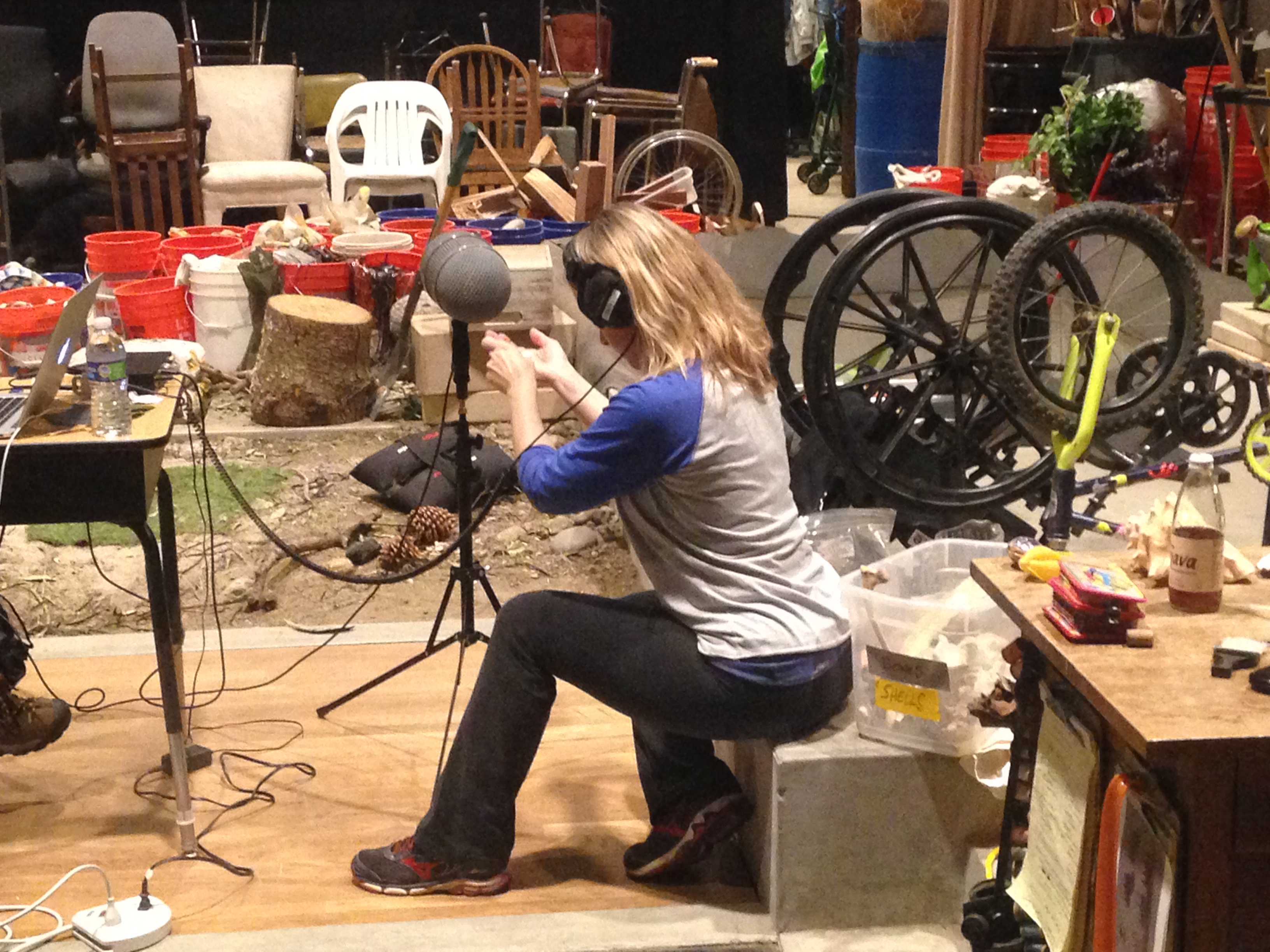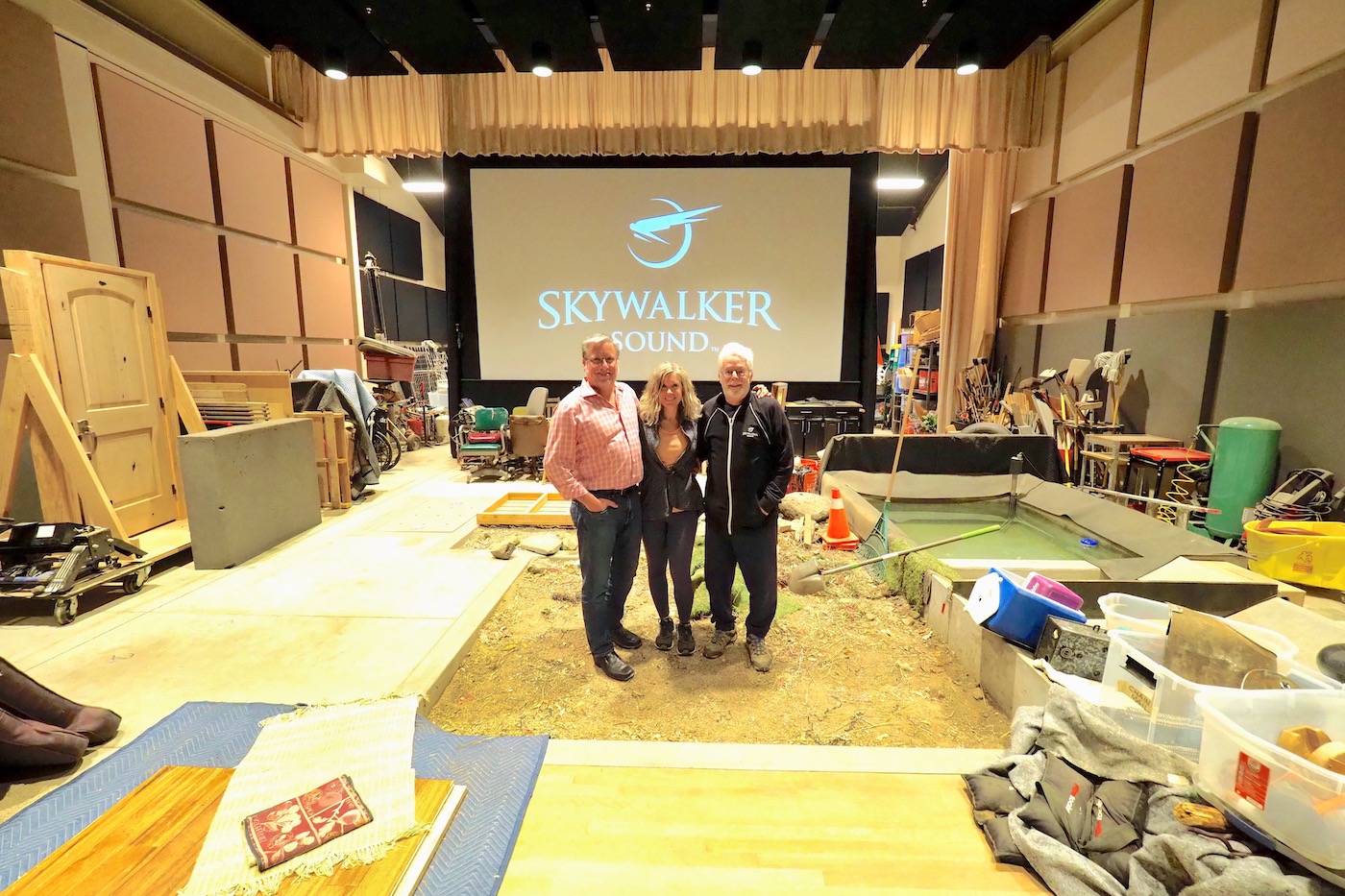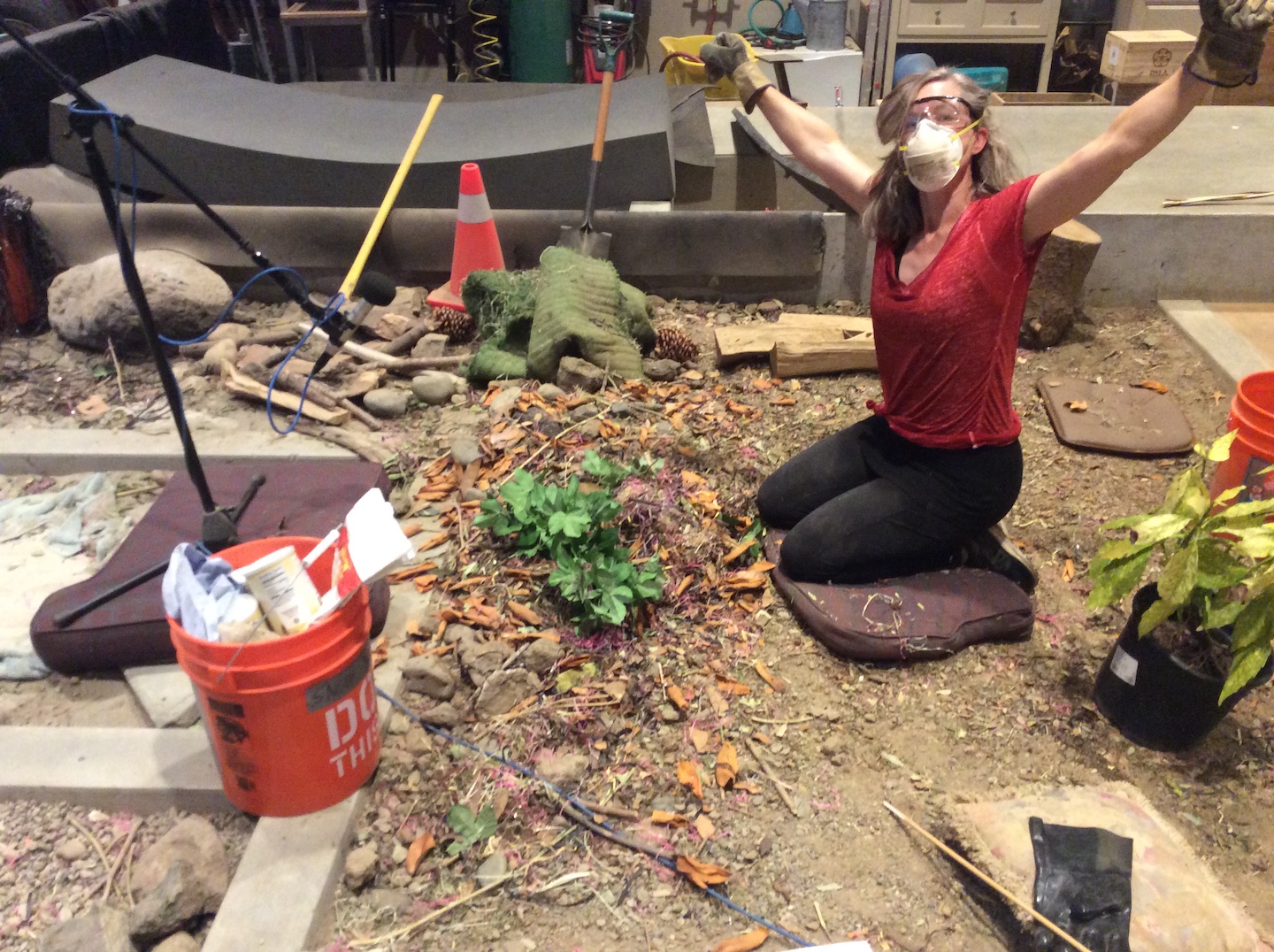'We needed to find the perfect sound of vibranium, an alien metal specific to the Marvel Universe': Foley artist Shelley Roden on creating audible movie miracles | reviews, news & interviews
'We needed to find the perfect sound of vibranium, an alien metal specific to the Marvel Universe': Foley artist Shelley Roden on creating audible movie miracles
'We needed to find the perfect sound of vibranium, an alien metal specific to the Marvel Universe': Foley artist Shelley Roden on creating audible movie miracles
The fine art of naturalising sound on 'Black Panther: Wakanda Forever'

The projection screen reflects light onto the Foley stage. I can just make out the edges of the built-in cement and metal surfaces around the floor’s perimeter and the large dirt pit centre stage. Bamboo poles, a hockey stick, and a shovel poke out from storage bins to my right. The corner of a car hood winks from underneath a furniture blanket. These tools wait their turn to become something other than what they were originally designed for.
There is a stillness in this repurposed garage the size of a small aircraft hangar. The cue begins. I focus on the screen watching Princess Shuri, played by Letitia Wright, move through the laboratory. Tensing my body, I manoeuvre my feet to convey what Shuri might be feeling in this moment as she waits anxiously to receive a remedy that could save her brother’s life. I walk in sync with her while staying in place in front of the microphone so the sounds of my sneakers can be transmitted, shaped, and recorded. I am a Foley artist working on Black Panther: Wakanda Forever.

I had the honour of walking Chadwick Boseman's footsteps on Black Panther (2018) and Letitia's on the new instalment of the Marvel superhero series. I also performed those of Tommy (Fionn Whitehead) on Christopher Nolan's Dunkirk (2017), Woody's and Buzz Lightyear's in Pixar’s Toy Story 4 (2019), and Mirabelle's in Disney’s Encanto (2021). My intention as a performer is to give the impression that the footsteps you're hearing belong to the characters you're seeing. To do this successfully, I immerse myself in the drama of the scene while using my mind to monitor the sound of my performance and allow my body the freedom it needs to create (Pictured above: Shelley records wing sounds for a sound piece created by artist Stephen Vitiello).
Shuri stops. The cue ends. If Scott and I both succeeded, we'll move to the next cue. If we didn't, we'll make another attempt.
“One more for me. I need a touch more room," Scott says. He then raises the fader of the room microphone so he can place my footsteps into the space of the laboratory.
I say, “Me, too. I need to speed up after three steps between the A and B [sides of the cut].”
Shuri is walking slightly faster from one shot to the next, so speeding up a beat or two in between will help create the impression that her pace is one continuous natural rhythm. We begin the second take with Scott punching into record after three footsteps on the A side, enabling him to keep the first three steps and record the remainder of the cue. This time we succeed.
On the Foley stage, the process is as follows: We view the project from beginning to end while tracking our initial reactions the first time through. A Foley editor then provides a list of cues for us to complete within the project. Cue by cue, we listen to the already existing music, sound effects, and dialogue, and imagine what tones or textures Foley can offer to help communicate the character, feelings, or narrative.

After the car chase sequence in Black Panther, for instance, Ulysses Klaue (Andy Serkis) rolls out of his overturned vehicle and the Black Panther approaches him. For the sound of the footsteps, we utilised the concrete at the back of the Foley stage because it is slightly textured and has a natural low sound. This helped us convey the idea that we were walking on asphalt.
To create the illusion that we were outside, we set foam baffles around our performance space to block out the reflective natural ambience of the room. We strained coffee grounds to create the fine grit under our soles, pointed a microphone at our feet, and chose our characters to perform (I was Black Panther, John was Klaue). (Pictured above: the Foley Archives Team – Scott Curtis on the left, Shelley, John Roesch – at Skywalker Ranch)
We next sweetened the footsteps with broken glass. We did this by opening our glass pit to perform a second track of sliding and pressing onto glass fragments. While performing this second track, we listened to the first track of our original footsteps in headphones and swirled glassy brushstrokes around the sounds of our footsteps like Impressionist painters.
As an example of how our work developed on Black Panther, one of the challenges was to find the perfect sound of vibranium, an alien metal specific to the Marvel Universe. We listened to what the sound effects editors cut in when Okoye (Danai Gurira) bangs her vibranium spear on cement. The effect sounded magical, metallic, and suspended. During our last salvage yard shopping trip, we found an S-shaped steel crowbar that sings a magical tone upon impact, so we hit that on cement to augment the sound effect. Together these two sounds – one sound effects, one Foley – create the sound of vibranium for that moment.

For the wing movements of Namor (Tenoch Huerta), we combined two separate tracks using feather dusters. The first was a small feather duster thwapped against my hand, the second was a thick ostrich feather duster thwapped against a chair cushion.
The Black Panther: Wakanda Forever Foley team was one part of the post-production sound team that helped create and produce the soundtrack envisioned by the film's director, Ryan Coogler. The sound supervisor communicated the director’s vision to us, the Foley editors mapped out our path and helped fold our sounds into the production track, and the re-recording mixers weaved the visceral elements from the Foley team into the fabric of the film. (Pictured above: Shelley creates leaf movement sounds for the “gale” wind character in 2019's Frozen II)
I invite you to surrender to the experience of Black Panther: Wakanda Forever. As the Foley team, we put our hearts and artistry into this film with the hope that you'll be as moved as we were when we saw it for the first time.
Add comment
The future of Arts Journalism
You can stop theartsdesk.com closing!
We urgently need financing to survive. Our fundraising drive has thus far raised £49,000 but we need to reach £100,000 or we will be forced to close. Please contribute here: https://gofund.me/c3f6033d
And if you can forward this information to anyone who might assist, we’d be grateful.

Subscribe to theartsdesk.com
Thank you for continuing to read our work on theartsdesk.com. For unlimited access to every article in its entirety, including our archive of more than 15,000 pieces, we're asking for £5 per month or £40 per year. We feel it's a very good deal, and hope you do too.
To take a subscription now simply click here.
And if you're looking for that extra gift for a friend or family member, why not treat them to a theartsdesk.com gift subscription?
more Film
 Steve review - educator in crisis
Cillian Murphy excels as a troubled headmaster working with delinquent boys
Steve review - educator in crisis
Cillian Murphy excels as a troubled headmaster working with delinquent boys
 Can I get a Witness? review - time to die before you get old
Ann Marie Fleming directs Sandra Oh in dystopian fantasy that fails to ignite
Can I get a Witness? review - time to die before you get old
Ann Marie Fleming directs Sandra Oh in dystopian fantasy that fails to ignite
 Happyend review - the kids are never alright
In this futuristic blackboard jungle everything is a bit too manicured
Happyend review - the kids are never alright
In this futuristic blackboard jungle everything is a bit too manicured
 Robert Redford (1936-2025)
The star was more admired within the screen trade than by the critics
Robert Redford (1936-2025)
The star was more admired within the screen trade than by the critics
 Blu-ray: The Sons of Great Bear
DEFA's first 'Red Western': a revisionist take on colonial expansion
Blu-ray: The Sons of Great Bear
DEFA's first 'Red Western': a revisionist take on colonial expansion
 Spinal Tap II: The End Continues review - comedy rock band fails to revive past glories
Belated satirical sequel runs out of gas
Spinal Tap II: The End Continues review - comedy rock band fails to revive past glories
Belated satirical sequel runs out of gas
 Downton Abbey: The Grand Finale review - an attemptedly elegiac final chapter haunted by its past
Noel Coward is a welcome visitor to the insular world of the hit series
Downton Abbey: The Grand Finale review - an attemptedly elegiac final chapter haunted by its past
Noel Coward is a welcome visitor to the insular world of the hit series
 Islands review - sunshine noir serves an ace
Sam Riley is the holiday resort tennis pro in over his head
Islands review - sunshine noir serves an ace
Sam Riley is the holiday resort tennis pro in over his head
 theartsdesk Q&A: actor Sam Riley on playing a washed-up loner in the thriller 'Islands'
The actor discusses his love of self-destructive characters and the problem with fame
theartsdesk Q&A: actor Sam Riley on playing a washed-up loner in the thriller 'Islands'
The actor discusses his love of self-destructive characters and the problem with fame
 Honey Don’t! review - film noir in the bright sun
A Coen brother with a blood-simple gumshoe caper
Honey Don’t! review - film noir in the bright sun
A Coen brother with a blood-simple gumshoe caper
 The Courageous review - Ophélia Kolb excels as a single mother on the edge
Jasmin Gordon's directorial debut features strong performances but leaves too much unexplained
The Courageous review - Ophélia Kolb excels as a single mother on the edge
Jasmin Gordon's directorial debut features strong performances but leaves too much unexplained

Comments
You rock, Shelley!!